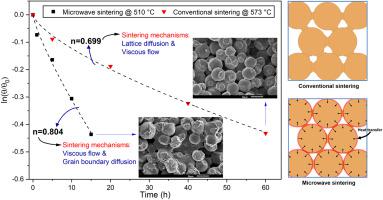Additive Manufacturing ( IF 11.0 ) Pub Date : 2020-10-09 , DOI: 10.1016/j.addma.2020.101655 Mojtaba Salehi , Hang Li Seet , Manoj Gupta , Hamidreza Farnoush , Saeed Maleksaeedi , Mui Ling Sharon Nai

|
Binder jetting provides a highly versatile two-step technology for additive manufacturing of difficult-to-process materials, including magnesium (Mg) alloys. Sintering in conventional (CT) furnaces has been extensively performed as the post-printing process to densify 3D printed parts, and exploring alternative sintering approaches is considerably lacking. The current study aimed to present a detailed comparative analysis of the consolidation of as-printed parts in CT and microwave (MW) furnaces. Accordingly, binderless 3D printed parts made of Mg-5.06Zn-0.15Zr powder were subjected to CT and MW sintering for various isothermal holding times and their physical, mechanical, and chemical properties, as well as sintering kinetics models, were thoroughly evaluated and compared. It was revealed that MW results in a three-fold reduction in sintering time compared to CT sintering counterparts. Supported by the analysis of sintering mechanisms, the MW sintering process is not merely governed by the thermal effect in a similar way to CT sintering, but the non-thermal phenomenon originating from the conversion of electromagnetic energy contributes substantially to the densification of 3D printed Mg parts by triggering the viscous flow mechanism. Furthermore, results indicated that the Mg sample sintered in MW for 15 h has an interconnected porous structure with comparable density, pores features, elastic modulus, and compressive strength to those found in human cortical bone types. Overall, this work enlightens the great potential of MW sintering as an attractive alternative to reduce the energy consumption and shorten the lead time of the binder jetting technology.
中文翻译:

通过微波烧结对增材制造的镁合金进行快速致密化
粘结剂喷射技术提供了一种高度通用的两步技术,用于增材制造难加工的材料,包括镁(Mg)合金。传统的(CT)炉中的烧结已广泛地用作后期印刷工艺以致密化3D打印的零件,并且非常缺乏探索替代烧结方法的方法。当前的研究旨在提供对CT和微波(MW)炉中印刷零件固结的详细比较分析。因此,对由Mg-5.06Zn-0.15Zr粉末制成的无粘合剂3D打印零件进行了不同的等温保持时间的CT和MW烧结,并对它们的物理,机械和化学性质以及烧结动力学模型进行了彻底的评估和比较。 。结果表明,与CT烧结相比,MW导致烧结时间减少了三倍。在烧结机理分析的支持下,MW烧结过程不仅以与CT烧结类似的方式受热效应支配,而且源自电磁能转化的非热现象也极大地促进了3D打印Mg的致密化。通过触发粘性流动机制来产生零件。此外,结果表明,以MW烧结15 h的Mg样品具有相互连接的多孔结构,其密度,孔特征,弹性模量和抗压强度与人类皮质骨类型中的可比。总体,


























 京公网安备 11010802027423号
京公网安备 11010802027423号